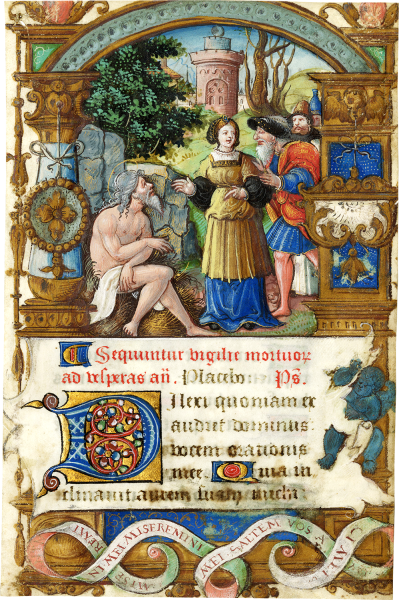


Description
These inventive and refined illuminated leaves come from a presumably lost Book of Hours illuminated by the Master of François de Rohan, most likely made for a patron in the court of King Francis I (r. 1515-1547). The first shows Bathsheba sitting on a wood plank over a bath as she receives a messenger from King David and is offered a plate of delicacies. David watches from a palace window holding a scepter as he gestures towards his envoy. The design shares many elements with other Bathsheba miniatures painted by the artist and his workshop. The detail of Bathsheba’s wood-plank seat appears in the Hours of Saulx-Tavannes, illuminated by the Master of François de Rohan in 1533 (Paris, Bibliothèque de l’Arsenal, MS 640, f. 67v), and the decorated column and greenery behind Bathsheba appears in the Hours of Anne de Montmorency (f. 66v, see Croizat-Glazer, 2013, p. 126; this manuscript presently with Antiquariat Heribert Tenschert).
The Bathsheba miniature is set inside an elaborate Italianate architectural frame with pediment, arabesques, and pendants. Text opening the Seven Penitential Psalms appears on a trompe-l’oeil cartouche punctured by a putto modeled in the same fleshy pink tones as Bathsheba. The twisting Solomonic column in the left border alludes to the Temple of Solomon that was to be constructed by David and Bathsheba’s future son. At right, the bust of a man inhabiting a pillar is most likely the prophet Nathan who chastised David for his adulterous act but later intervened to have Solomon proclaimed king, passing over David's elder son. These highly inventive and narrative borders are on par with the artist’s most imaginative work, including the portrait of Francis I shown in the guise of King David and figuratively witnessing the encounter with Bathsheba in the Hours of Francis I, now in New York (Metropolitan Museum of Art, 2011.353, f. 67r; see Croizat-Glazer 2013, esp. pp. 128-129). The artist frequently dated his works in the frames, and a white cartouche in the lower edge bears a very faint inscription “1543"(?), perhaps added later.
The second leaf depicts Job seated on a dung heap with a thin gold halo and a white cloth, sorrowfully gazing upwards. His wife and friends approach him, gesturing to each other, with a hilly landscape in the background with barren trees and a circular orb-topped tower. The architectural frame includes a rounded arch and pillars draped with pendants. At bottom is a looping banderole with Job’s words in Latin (Job 19:21): “Miseremini mei miseremini mei saltem vos amici mei” (Have pity on me, have pity on me, at least you my friends). The text opens the Office of the Dead, again on a trompe-l’oeil cartouche, in this case punctured by a shadowy blue putto.
Active in Paris and named for his illuminations for La Fleur de Vertu, translated by François II de Rohan (Paris, BnF, MS Fr. 1877), the Master of François de Rohan is known for his imaginative subject matter and lively narration that set his Books of Hours apart, as noted by Myra Orth (1998, p. 77). These two miniatures probably date to the later period of the artist’s oeuvre, at the height of his courtly commissions. Between 1539 and 1542 the Master of François de Rohan illuminated a Book of Hours for King Francis I and a presentation copy of the poem La Coche by Marguerite de Navarre (1492-1549), sister of Francis I, intended as a gift to the king's mistress, Anne de Pisseleu d'Heilly. Numerous portly putti are painted bursting through the trompe-l’oeil parchment surface in the 1541/42 La Coche manuscript (Chantilly, Musée Condé, MS 522). Although putti appear frequently in the artist’s earlier works, only around 1540 and after do their limbs pierce the illusionistic cartouche, as in the two present leaves.
Both leaves trimmed, with small areas of staining and pinholes to the upper edge, with uniform abrasions and losses of pigment at edges, and both miniatures slightly rubbed in places, otherwise in good condition with bright pigments. Both leaves formerly mounted to paperboard supports, the verso sides with blue and red decorations rubbed and with show through from the recto. The verso sides are written on 19 lines in a single column in brown ink in an angular Gothic bookhand with initials in gold on red and blue, both leaves numbered in a modern (19th century?) hand at the lower edge, “10” (Bathsheba leaf) and “12” (Job leaf), and in pencil “X L” and “X R”(?).
Provenance
Private Collection, France
Literature
Unpublished; for comparisons, see:
M. D. Orth, “The Master of François de Rohan: A Familiar French Renaissance Miniaturist with a New Name,” in M. Brown and S. McKendrick, eds., Illuminating the Book: Makers and Interpreters. Essays in Honour of Janet Backhouse, London, 1998, pp. 69-91.
M. D. Orth, Renaissance Manuscripts: The Sixteenth Century, Turnhout, 2015, I, col. pl. 34a-e, col. pl. 37, pl. 166 and 171, and p. 292.
Y. Croizat-Glazer, “Sin and Redemption in the Hours of François I (1539-40) by the Master of François de Rohan,” Metropolitan Museum Journal 48 (2013): 121-142.
Online Resources
Hours of Saulx-Tavannes, Paris, Bibliothèque de l’Arsenal, MS 640
https://gallica.bnf.fr/ark:/12148/btv1b550057309
Hours of Francis I, New York, Metropolitan Museum of Art, 2011.353
https://www.metmuseum.org/art/collection/search/238581
